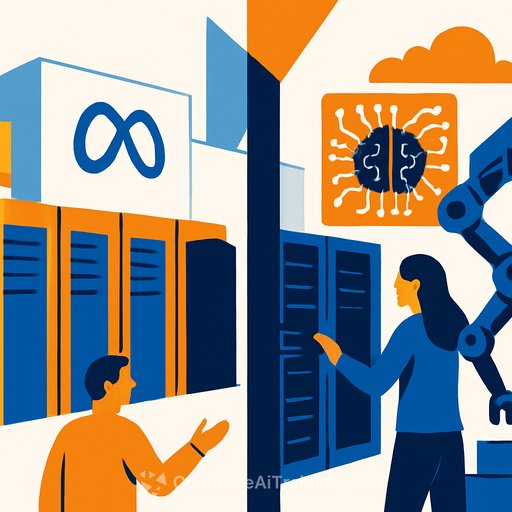Meta’s Dual-Track Data Center Strategy: Building AI Campuses, Leasing Cloud, and Scaling Nationwide
Meta is redefining data center development to meet the surging demand for AI compute. From billion-dollar AI campuses in Louisiana and Ohio to a $10 billion Google Cloud deal and a new data center in Kansas City, the company balances large-scale ownership with strategic cloud partnerships. This approach reflects the evolving needs of hyperscale infrastructure in the AI era.
Investing in AI-Optimized Data Centers
Meta is heavily investing in AI-focused campuses like Hyperion in Louisiana and Prometheus in Ohio. These sites are designed to support advanced AI models and Meta's ambitions for artificial general intelligence (AGI). The Hyperion campus, spanning roughly 2,250 acres in Richland Parish, Louisiana, aims to deliver up to 5 gigawatts (GW) of computational power, making it the largest data center Meta has ever built.
Construction for Hyperion started in late 2024 and will run through 2030. Initial targets include reaching 1.5 GW by 2027, scaling up to 5 GW over time. These superclusters will supply critical compute for Meta’s Superintelligence Labs and future model training while reducing reliance on public cloud providers. Vertical integration gives Meta greater control over costs and deployment speed.
Powering Large-Scale AI Campuses
Supplying power to such massive campuses in rural areas presents unique challenges. Entergy, the regional utility, plans a $1.2 billion, 100-mile, 500kV transmission line to deliver bulk power to Hyperion. This includes new substations, switchyards, and multiple high-voltage lines directly connected to Meta’s property.
To meet immediate load, Entergy is seeking approval to build three combined-cycle gas plants totaling about 2.25 GW at a cost near $4 billion. These plants will provide on-site power while transmission upgrades are completed. The proposals have sparked concerns from local communities and energy advocates regarding costs, environmental impact, and long-term ratepayer protections.
Meta is addressing sustainability by implementing efficient cooling systems, stormwater capture, and water-saving fixtures aligned with its water-positive goal by 2030. The company also commits to offsetting data center energy use with at least 1,500 MW of new renewable energy, including solar, wind, geothermal, and potential nuclear power sources. However, much of the initial power will come from natural gas due to current grid constraints.
Prometheus: Meta’s First AI “Titan” Supercluster
Prometheus, located in New Albany, Ohio, is Meta’s first multi-GW AI supercluster, set to come online in 2026. The campus uses innovative rapid deployment tents—aluminum structures covered with weatherproof fabric—to speed construction. This method reduces build time while accommodating the massive scale of AI infrastructure.
Power for Prometheus includes significant behind-the-meter generation. Ohio regulators approved a 200 MW natural gas plant, Socrates South, to directly supply the campus. Two such plants will eventually provide 400 MW of on-site generation, reducing grid strain while regional transmission upgrades proceed. These upgrades, managed by AEP and approved by PJM, carry a $1.7 billion price tag and will take 7–10 years to complete.
Financing and Scale of Investment
The full buildout of Meta’s AI data center infrastructure is expected to cost around $10 billion. Reports indicate Meta secured $29 billion in financing, including $26 billion in debt managed by PIMCO and $3 billion in equity from Blue Owl Capital, with Morgan Stanley facilitating the process.
This shift toward owning and co-developing AI facilities aligns with strategies employed by other hyperscalers like Amazon and Microsoft. Meta’s capital expenditure for 2025 is projected at $64–72 billion, nearly double the 2024 spend, underscoring the priority of these AI projects for the company’s future.
Kansas City: Expanding Traditional Data Center Capacity
Alongside AI campuses, Meta continues to expand its conventional data center footprint. The $1 billion Kansas City facility, operational since August 2025, supports the existing global infrastructure for Meta’s platforms. The project involved over 1,500 construction workers at peak and will create more than 100 long-term jobs.
This campus emphasizes sustainability with LEED Gold certification, advanced water-efficient cooling, and stormwater capture, saving over a million gallons of potable water during construction. Its electricity use is matched 100% with renewable energy. The site also serves as a community hub, offering grants and AI education initiatives for local organizations and businesses.
Leasing Cloud Capacity with Google
Despite heavy investment in owned infrastructure, Meta maintains a significant cloud leasing strategy. Just before the Kansas City data center opening, Meta signed a six-year, $10 billion deal with Google Cloud to supplement AI compute capacity. This arrangement allows Meta to meet immediate AI training and deployment needs while its own campuses come online.
This deal highlights how hyperscalers depend on multiple infrastructure models to accommodate rapid AI growth. It also strengthens Google’s position as a key cloud provider in the hyperscale market.
Summary: A Layered Approach to AI Infrastructure
Meta’s strategy blends large-scale owned AI campuses with cloud leasing and traditional data center expansion. This layered approach reflects the urgency of AI compute demand and the challenges of building power and infrastructure at scale.
The projects in Louisiana and Ohio are closely watched across the industry. Success in integrating multi-gigawatt campuses with massive power generation and transmission projects could set a new template for hyperscale AI infrastructure—one that is vertically integrated, power-secure, and financed at an unprecedented scale.
At the same time, reliance on cloud competitors emphasizes that no single model suffices in today’s market. For real estate and construction professionals, this signals new complexities and opportunities in data center development, where speed, scale, energy planning, and financial structuring all intersect.
```Your membership also unlocks:






